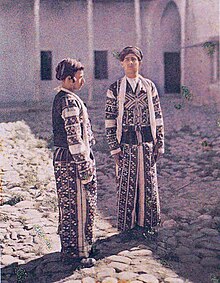| This article needs additional citations for verification. Please help improve this article by adding citations to reliable sources. Unsourced material may be challenged and removed. Find sources: "Bahdinan" – news · newspapers · books · scholar · JSTOR (September 2021) (Learn how and when to remove this message) |

Former Kurdish Principality
Bahdinan (Bahdīnān) or Badinan (Bādīnān) was one of the most powerful and enduring Kurdish principalities. It was founded by Baha-al-Din originally from Şemzînan area in Hakkari in sometime between 13th or 14th century CE. The capital of this emirate was Amedi for a long time. The rulers of the Bahdinan Emirate governed over the Emirate since the Abbasid Empire, an early dynasty in Islamic history.
It was centered in the town of Amadiya (or Amêdî) in the present-day Duhok governorate in Iraqi Kurdistan.
Geographical extent
Bahdinan generally consisted of the region north and northeast of the Mosul plain. Its capital was the town of Amadiya (Amêdî), and it also included Akre, Shush, and Duhok, along with the Zebari lands along the Great Zab river.. The principality of Bahdinan sometimes also extended to include Zakho in the west. To the north, Bahdinan bordered the principalities of Bohtan and Hakkâri, and to the south it bordered the principality of Soran.
The name "Bahdinan" is still applied to the region inhabited by the Barwari, Doski, Gulli, Muzuri, Raykani, Silayvani, Sindi, and Zebari tribes.
According to Evliya Celebi the principality was divided into the following districts: Aqra, Zakho, Shikhoyi, Duhok, Zibari, and Muzuri.
The districts were autonomous units under their own rulers who were appointed by the Khan of Amadiya. In addition to this, there were tribal chieftains with formalized positions (for example, the chiefs of the Sindi and Silvane tribes needed confirmation from the ruler of Zakho).
History
The Bahdinan principality originated during the late Abbasid period, sometime around 1200. The Sharafnama of Sharaf al-Din Bitlisi contains an account of the principality's history for two centuries, from the time of the Timurid ruler Shah Rukh in the 1400s until 1596. The Bahdinan amir Hasan, who was a client of the Safavid shah Isma'il I, expanded the principality to include Duhok and the Sindi territory north of Zakho. Hasan's son Husayn later reigned as a client of the Ottoman sultan Suleiman the Magnificent. Husayn's son Qubād was deposed and killed by members of the Muzuri tribe; Qubād's son, Saydī Khān, was later reinstalled with Ottoman help. In the early 1600s, the principality of Ardalan captured the Bahdinan capital of Amadiya and appointed a governor there; sources say little about Bahdinan for a century afterward.
The principality seems to have reached its peak during the reign of Bahrām Pasha, who ruled from 1726 to 1767. Bahrām was succeeded by his son Ismā'īl Pasha (r. 1767–1797), whose reign involved conflict with his brothers (who were variously based at Zakho and Akre). Ismā'īl's son Murād Khān was deposed by his cousin Qubād with the assistance of the Baban pasha of Sulaymaniyah; Qubād was overthrown by members of the Muzuri tribe in 1804 (just like his earlier namesake). He was replaced by 'Ādil Pasha, whose position was affirmed by the Jalili pasha of Mosul; he died in 1808 and was succeeded by his brother Zubayr. In 1833, Muhammad Pasha of Rawanduz captured Akre and Amadiya, overthrew Sā'īd Pasha of Bahdinan, and went on to capture Zakho. The Bahdinan principality never fully recovered, and it was annexed into the Ottoman Sanjak of Mosul in 1838.
Threatened by the expansionist and centralizing efforts of the Ottoman and Safavid empires, Bahdinan princes were drawn into prolonged confrontations with these two rival powers. The Bahdinan rulers, Ismail Pasha and Muhammad Said Pasha were deposed by the emir of the neighboring Soran principality in 1831. However, their rule was restored after the Ottomans defeated Soran Emirate in 1836.
The most famous ancient library in the region, in the Qubehan school at Amadiya, was destroyed by British troops putting down a revolt in the region in 1919, although some 400 manuscripts were rescued and eventually found their way into the Iraq Museum's collection.
References
- Michael Eppel (September 13, 2016). A People Without a State: The Kurds from the Rise of Islam to the Dawn of Nationalism. University of Texas Press. pp. 34–. ISBN 978-1-4773-0913-1.
- ^ Ates, Sabri (2021), Gunes, Cengiz; Bozarslan, Hamit; Yadirgi, Veli (eds.), "The End of Kurdish Autonomy: The Destruction of the Kurdish Emirates in the Ottoman Empire", The Cambridge History of the Kurds, Cambridge: Cambridge University Press, p. 76, ISBN 978-1-108-47335-4, retrieved December 15, 2021
- ^ MacKenzie, D.N. (1960). "Bahdīnān". In Gibb, H. A. R.; Kramers, J. H.; Lévi-Provençal, E.; Schacht, J.; Lewis, B. & Pellat, Ch. (eds.). The Encyclopaedia of Islam, Second Edition. Volume I: A–B. Leiden: E. J. Brill. p. 920. OCLC 495469456.
- ^ Bruinessen, Martin van (January 2000). "Kurdistan in the 16th and 17th centuries, as reflected in Evliya Çelebi's Seyahatname". The Journal of Kurdish Studies 3 (2000), 1-11.
- Faraj, S.S. Libraries and Librarianship in Iraqi Kurdistan. In: Libraries in the Early 21st Century: An International Perspective, edited by R.N. Sharma, vol.2, 297-311. 2012. Berlin: de Gruyter Saur.
- Bahdinan, Encyclopædia Iranica, p. 485, By Amir Hassanpour.
- Bahdīnān , The Encyclopaedia of Islam, Brill Academic Publishers.
See also
| Islamic dynasties in Mashriq region | |
|---|---|
|
This Middle East–related article is a stub. You can help Misplaced Pages by expanding it. |